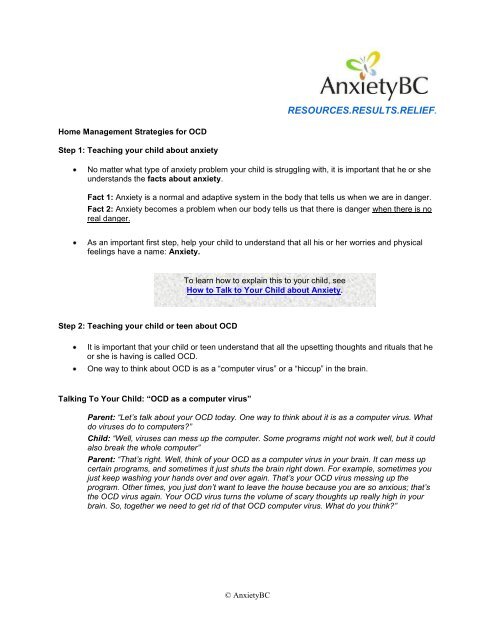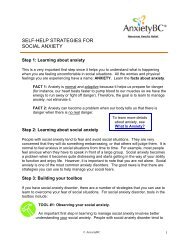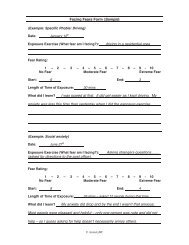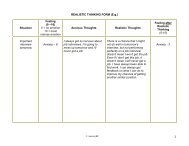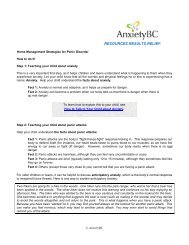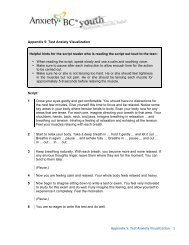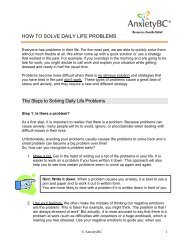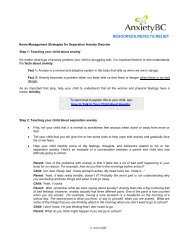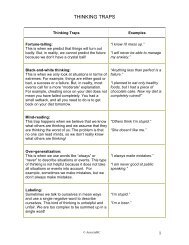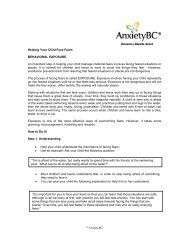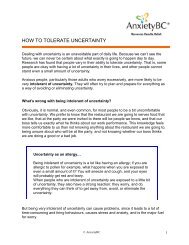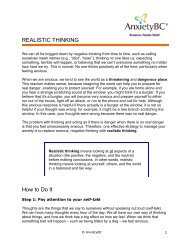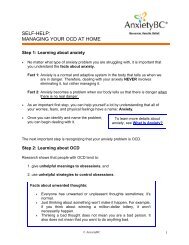Home Management Strategies for OCD - Anxiety BC
Home Management Strategies for OCD - Anxiety BC
Home Management Strategies for OCD - Anxiety BC
Create successful ePaper yourself
Turn your PDF publications into a flip-book with our unique Google optimized e-Paper software.
<strong>Home</strong> <strong>Management</strong> <strong>Strategies</strong> <strong>for</strong> <strong>OCD</strong><br />
Step 1: Teaching your child about anxiety<br />
© <strong>Anxiety</strong><strong>BC</strong><br />
RESOURCES.RESULTS.RELIEF.<br />
No matter what type of anxiety problem your child is struggling with, it is important that he or she<br />
understands the facts about anxiety.<br />
Fact 1: <strong>Anxiety</strong> is a normal and adaptive system in the body that tells us when we are in danger.<br />
Fact 2: <strong>Anxiety</strong> becomes a problem when our body tells us that there is danger when there is no<br />
real danger.<br />
As an important first step, help your child to understand that all his or her worries and physical<br />
feelings have a name: <strong>Anxiety</strong>.<br />
Step 2: Teaching your child or teen about <strong>OCD</strong><br />
It is important that your child or teen understand that all the upsetting thoughts and rituals that he<br />
or she is having is called <strong>OCD</strong>.<br />
One way to think about <strong>OCD</strong> is as a “computer virus” or a “hiccup” in the brain.<br />
Talking To Your Child: “<strong>OCD</strong> as a computer virus”<br />
To learn how to explain this to your child, see<br />
How to Talk to Your Child about <strong>Anxiety</strong>.<br />
Parent: “Let’s talk about your <strong>OCD</strong> today. One way to think about it is as a computer virus. What<br />
do viruses do to computers?”<br />
Child: “Well, viruses can mess up the computer. Some programs might not work well, but it could<br />
also break the whole computer”<br />
Parent: “That’s right. Well, think of your <strong>OCD</strong> as a computer virus in your brain. It can mess up<br />
certain programs, and sometimes it just shuts the brain right down. For example, sometimes you<br />
just keep washing your hands over and over again. That’s your <strong>OCD</strong> virus messing up the<br />
program. Other times, you just don’t want to leave the house because you are so anxious; that’s<br />
the <strong>OCD</strong> virus again. Your <strong>OCD</strong> virus turns the volume of scary thoughts up really high in your<br />
brain. So, together we need to get rid of that <strong>OCD</strong> computer virus. What do you think?”
Talking To Your Child: “<strong>OCD</strong> as a hiccup”<br />
Parent: “Let’s talk about your <strong>OCD</strong> today. One way to think about it is as a hiccup in your brain.<br />
What happens when we hiccup?”<br />
Child: “We make a hiccup sound, and it keeps happening again and again.”<br />
Parent: “That’s right. It just keeps coming back, and we have no control. Well, <strong>OCD</strong> is like a<br />
hiccup. You have thousands of thoughts in your head every day, but when you have an <strong>OCD</strong><br />
hiccup, the same thought comes up again and again, and just won’t go away. For example,<br />
sometimes when you go to bed at night, your brain has an <strong>OCD</strong> hiccup. Do you know what it is?<br />
Child: “Yes. I check all the doors and windows to make sure they are locked.”<br />
Parent: “Exactly. The <strong>OCD</strong> hiccup in your brain tells you that you need to check again and again<br />
to make sure that everything is locked. So, together we need to stop your brain from hiccupping.<br />
What do you think?”<br />
Step 3: Building your child’s toolbox<br />
The best way to help children or teens deal with <strong>OCD</strong> is to give them tools that can be used instead of the<br />
compulsions. For <strong>OCD</strong>, tools in the toolbox include:<br />
Tool #1: Naming the bully<br />
<strong>OCD</strong> can quickly take over your child’s life. A good way <strong>for</strong> you to start helping your child tackle<br />
<strong>OCD</strong> is to encourage him or her to see the <strong>OCD</strong> as a separate entity, rather than a mistake on<br />
the part of your child. To do this, children and teens are encouraged to see their <strong>OCD</strong> as a bully<br />
that is trying to control them and tell them what to do.<br />
Have your child give a name to the <strong>OCD</strong> bully, such as “the worry bug,” “the pest,” or “the <strong>OCD</strong><br />
monster.”<br />
You and your child can then talk about <strong>OCD</strong> without blaming anyone <strong>for</strong> it. For example, “It looks<br />
like the <strong>OCD</strong> monster has been bullying you around today!”<br />
TOOL #2: Changing or Delaying the Rituals<br />
This tool is especially useful with younger children. Once you begin helping your child to deal with<br />
<strong>OCD</strong>, you can ask him or her to delay or change a ritual slightly as a first attempt to “boss back” the <strong>OCD</strong>.<br />
For example, “Let’s try bossing back the <strong>OCD</strong> by having you wait 5 minutes be<strong>for</strong>e washing your hands,”<br />
or “Let’s try putting the right sock on be<strong>for</strong>e the left sock.” Afterward, make sure to praise your child’s<br />
accomplishment, and remind him or her that this is how we “boss back the <strong>OCD</strong>”.<br />
Helpful Tip:<br />
Delaying or changing an <strong>OCD</strong> ritual can be very difficult. If your child is very<br />
anxious, it is OK to take very small steps. For example, delaying washing hands<br />
<strong>for</strong> 30 seconds.<br />
You might even want to make a fear ladder with your child that has gradually<br />
harder exercises <strong>for</strong> him or her to do, such as, starting with a delay of 30<br />
seconds to not washing hands all day. (See Helping your Child to Face<br />
Fears: Exposure <strong>for</strong> more in<strong>for</strong>mation.)!<br />
It is a good idea to remind your child whenever <strong>OCD</strong> is being a bully. For example, “I see that you<br />
are arranging all your socks in the sock drawer. Is the <strong>OCD</strong> bully acting up again?”<br />
Don’t <strong>for</strong>get to give lots of rewards and praises to your child <strong>for</strong> any attempts he or she makes to<br />
fight off the <strong>OCD</strong> rituals.<br />
© <strong>Anxiety</strong><strong>BC</strong><br />
2
Praise, Praise, Praise!!<br />
Because it is hard work to manage <strong>OCD</strong>, your child needs lots of<br />
encouragement. Some helpful rewards can be:<br />
Tool #3: Addressing Reassurance-Seeking<br />
Stickers that your child can put on a posterboard every time he or she<br />
tries to boss back <strong>OCD</strong><br />
Verbal praise: “What a great job you are doing!”; “I’m so proud of you!”;<br />
“Look how brave you are!”<br />
Rewards at home: extra TV time, family time together, playing a fun<br />
board game, dinner at a favourite restaurant, or a new toy. Some<br />
rewards should be more long-term. For example, “When you are able to<br />
boss back the <strong>OCD</strong> <strong>for</strong> a whole day and not check any doors, we will go<br />
to the toy store and get a new video game <strong>for</strong> you.”<br />
Because children with <strong>OCD</strong> often want reassurance from their parents, this is an important tool,<br />
not only <strong>for</strong> your child, but also <strong>for</strong> you.<br />
When your child asks <strong>for</strong> reassurance, <strong>for</strong> example, “are you sure the kitchen is clean?”, you can<br />
answer in the following ways:<br />
o “What if it’s not completely clean? What would happen then?”<br />
o If your child gets very anxious, you can remind him or her that <strong>OCD</strong> is being a bully, and<br />
ask which tool he or she can use from the <strong>OCD</strong> toolbox.<br />
o You can give your child reassurance once, and then if he or she asks again, you can<br />
reply: “I already answered that question. Why don’t you try using your toolbox?”<br />
To learn how to explain this to your child, see<br />
How to Address Excessive Reassurance Seeking .<br />
Tool #4: Facing Fears: Exposure and Response Prevention<br />
The majority of the work in helping your child or teen “boss back” the <strong>OCD</strong> is in helping your child to<br />
gradually face his or her fears. This involves developing a list of all of your child’s rituals (e.g., washing<br />
hands, checking doors), as well as a list of situations when your child completes the rituals (e.g., when<br />
touching the doorknob or when going to bed at night). With <strong>OCD</strong>, this is sometimes called “Exposure and<br />
Response Prevention,” because children or teens need to face their fears (e.g., touching the doorknob),<br />
and then deliberately not do their compulsion (e.g., washing hands). Facing fears is the exposure part;<br />
not doing the compulsion is called “response prevention.” Gradually, your child can begin reducing these<br />
behaviors by not doing the compulsions and then tolerating the anxiety until it subsides. This tool will<br />
probably be the most effective of all the <strong>OCD</strong> tools.<br />
© <strong>Anxiety</strong><strong>BC</strong><br />
3
Tool #5: Stopping Parent-Assisted Rituals<br />
Once you start helping your child or teen to battle <strong>OCD</strong>, you might think that stopping all the rituals that<br />
you yourself have become involved in is a good idea. For example, your child might ask you to clean the<br />
house or do the laundry in a certain way (such as using bleach everywhere, or cleaning clothes<br />
separately). Although one of the goals in managing <strong>OCD</strong> is to stop all the rituals you are involved in,<br />
suddenly stopping them all can be very overwhelming <strong>for</strong> your child. When your child starts facing his or<br />
her fears, these parent-assisted rituals can be another part of <strong>OCD</strong> to boss back. That is, you can make a<br />
fear ladder with your child, to gradually reduce these rituals.<br />
Tool #6: Coping Cards<br />
Tip #1: Your Child or Teen is the Boss!<br />
It is important to ultimately let your child decide when he or she is ready to<br />
reduce, change, or eliminate rituals that you assist with. Your child needs to feel<br />
“in charge” of bossing back <strong>OCD</strong>.<br />
Tip #2: Be Patient<br />
Most parents are very frustrated with all the rituals they are involved in.<br />
However, it is important to remember not to get angry at your child <strong>for</strong><br />
unsuccessful attempts at bossing back <strong>OCD</strong>. Instead, focus on successes! Give<br />
your child lots of praise, even if his or her attempt to stop some rituals was<br />
unsuccessful. Being positive is extremely motivating.<br />
One of the most helpful tools will be the things that your child can say to him or herself to help deal with<br />
anxiety. Coping cards are very useful <strong>for</strong> this. (see Developing and Using Cognitive Coping Cards<br />
with Your Child). Some helpful coping statements <strong>for</strong> <strong>OCD</strong> include:<br />
“There’s my <strong>OCD</strong> monster! He’s trying to bully me again! I don’t have to listen.”<br />
“I feel really anxious right now, but I know that feeling will go away soon.”<br />
For more detail and a sample of an <strong>OCD</strong> ladder, see<br />
Helping your Child to Face Fears: Exposure.<br />
Helpful Tip:<br />
Some of the <strong>OCD</strong> fears that your child has might be based on false in<strong>for</strong>mation<br />
or ignorance. For example, many children with <strong>OCD</strong> who wash their hands<br />
excessively don’t know that washing your hands repeatedly is not good <strong>for</strong> you.<br />
It is important to have some germs; otherwise, we never get to build up our<br />
immunity. Your child can put this kind of in<strong>for</strong>mation onto a coping card. If your<br />
child teen is unsure whether this new in<strong>for</strong>mation is true, make a trip to the<br />
library or look up the in<strong>for</strong>mation on the internet.<br />
Tool #7: STOP plan: Challenging Unhealthy Thoughts<br />
This strategy involves challenging some of the unhealthy beliefs that your child holds about his or her<br />
obsessions. For example, your child might think, “If I don’t line up my shoes perfectly, my mom will die!”<br />
This thought is obviously unrealistic and inaccurate, but it might be hard <strong>for</strong> your child to see that when he<br />
© <strong>Anxiety</strong><strong>BC</strong><br />
4
or she is feeling anxious. The STOP plan can help your child to STOP these unhealthy thoughts, and<br />
rethink whether or not they are in fact true. For more in<strong>for</strong>mation on the STOP plan <strong>for</strong> younger children,<br />
see Healthy Thinking <strong>for</strong> Young Children. To help teens think more realistically, see Realistic<br />
Thinking <strong>for</strong> Teens.<br />
Tool #8: In<strong>for</strong>mation about Obsessions<br />
Some children or teens have obsessions that involve very upsetting, scary, or gross thoughts. For<br />
example, some children may have unwanted thoughts like “What if I pushed somebody in front of a car?”<br />
or “I thought about my mom getting hit by a car today; that must mean that it will happen!” A good way to<br />
help your child deal with these types of thoughts it to talk to them about obsessions. Here are some facts<br />
about obsessions:<br />
Fact #1: Everybody has unwanted or unpleasant thoughts sometimes. It is normal.<br />
Fact #2: Just thinking about something won’t make it happen. For example, if you think about<br />
breaking your leg, it won’t necessarily happen.<br />
Fact #3: Thinking a bad thought does not mean you are a bad person. It also does not mean you<br />
want to do anything bad. Obsessions are just “garbage of the mind.”<br />
Fact #4: The best way to boss back these thoughts is to ignore them. If you don’t pay attention to<br />
the thought, it will go away on its own. If you try to fight it or push it out of your head, it will keep<br />
coming back!<br />
Step 4: Building on Bravery<br />
One final tip:<br />
Although all of these tools can be very effective in helping you to manage your<br />
child’s <strong>OCD</strong>, sometimes it is not enough. Sometimes children have very severe<br />
<strong>OCD</strong>, and despite all your best ef<strong>for</strong>ts, they may still be struggling daily. If this is<br />
the case with your child, it is a good idea to obtain some professional help in<br />
dealing with <strong>OCD</strong>, either through a consult with your GP, a psychiatrist, or a<br />
child psychologist/mental health worker.<br />
Your child's progress comes from hard work. If you are noticing improvements, both you and your child<br />
deserve lots of credit! Learning to overcome anxiety is like exercise – your child needs to "keep in shape"<br />
and practice his or her skills regularly, and make them a habit. This is true even after your child is feeling<br />
better and has reached his or her goals.<br />
Don't be discouraged if your child has lapses and returns to old behaviors every once in a while,<br />
especially during stressful times or transitions. This is normal, and just means that one or two tools in the<br />
toolbox need to be practiced again. Remember, coping with anxiety is a lifelong process.<br />
Hint: Occasionally remind your child what he or she was<br />
not able to do be<strong>for</strong>e learning how to cope with anxiety<br />
and face fears. It can be very encouraging <strong>for</strong> your child to<br />
see how far he or she has come!.<br />
© <strong>Anxiety</strong><strong>BC</strong><br />
5


